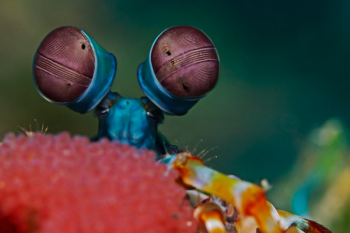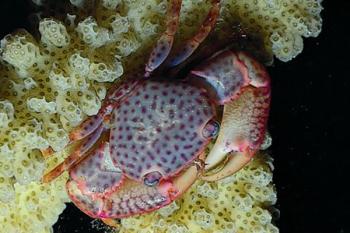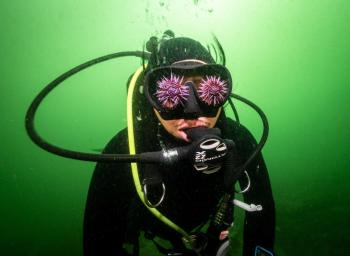
Lobsters, shrimp and crabs and other crustaceans have an amazing diversity of both simple and compound eyes, each with standard crustacean features. And some have their own unique features.
There are over 52,000 species of crustaceans, which can be found in almost every conceivable type of habitat including coastal, pelagic, benthic, and deep marine; as well as freshwater and terrestrial. “The wide range of light environments represented by these diverse habitats has operated together with the overall morphological diversity within the Crustacea to produce a dizzying array of crustacean visual systems.”
The Eyes Have It
Almost every optical system known to exist in eyes can be found in one crustacean or another, ranging from simple pigment cups to a variety of simple designs (eyes that have a single aperture and a retinal sheet) to a uniquely diverse set of compound eye types.
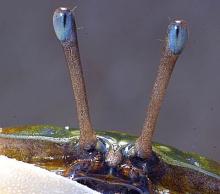
Compound Eyes
Compound eyes are the designs used by all the large, well-known crustaceans—lobsters, shrimp, crabs—as well as by a vast diversity of crustaceans that are less familiar to most of us: krill, mysids, water fleas, and mantis shrimps, for example. The largest diversity of compound-eye optical designs in any group of animals is found within those larger crustaceans. Some adults have compound eyes on stalks. The stalks give the advantage of an expanded visual field like a telescope. A light-sensitive receptor called an ommatidium, operating independently, is the basis for their vision. Individual ommatidia see only a tiny part of the scene. The entire scene is created when all the ommatidia are added together. Each eye can have hundreds of ommatidia and the arrangement of ommatidia determines the animal’s visual field.
Mantis Shrimp
The most specialized eyes of all are found in the stomatopods, or mantis shrimp. Mantis shrimp separated from other crustaceans hundreds of millions of years ago, so their evolutionary adaptations have developed over truly deep time. They have aggressive and lightning-fast ways to capture prey. Humans can process three channels of color (red, green and blue), while mantis shrimp perceive the world through 12 channels of color and can detect ultra-violet (UV) and polarized light, aspects of light humans can’t see with the naked eye.
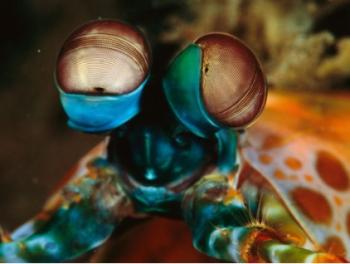
The mantis shrimp’s compound eyes have dorsal and ventral regions resembling typical crustacean compound designs. And they also have a unique region specialized for color analysis. Rhabdoms (transparent, crystalline receptive structures that act like rods in our eyes) of the ommatidia are longitudinally divided into three distinct regions: an ultraviolet (UV) receptor, a shorter-wavelength receptor and a longer-wavelength receptor. Each of the total of 12 photoreceptors has a different color sensitivity, potentially contributing to a color-vision system with 12 channels. Mantis shrimp can discriminate both human-visible and UV colors, but with limited precision compared to other color-vision systems.
The Better to See You With
Clearly mantis shrimp depend heavily on their vision. Their eyes, which have independent depth perception, actively scan the environment, track moving objects and fix their eyes on targets. Mantis shrimp species live in, or just beneath, the intertidal zone where illumination is bright with all the color wavelengths (broad-spectrum). Even when species live in deeper water where light has a narrowed color range, they adjust their color vision to match the light available. Mantis shrimp species from different habitats have different sets of sensitivities that are appropriately tuned for their specific photic environments.
The changes in color sensitivity among species are produced both by using different sets of visual pigments and different sets of filters. This habitat-specific tuning allows all species to maintain color vision, despite differences in the slight properties of the environments they inhabit.
New studies suggest that mantis shrimp vision might not be as advanced as once believed. They do have up to 12 photoreceptors. We humans only have three. While mantis shrimp eyes were once thought to discern a kaleidoscope of colors with unmatched precision, research has found that their ability to discriminate among colors is surprisingly low.
Instead of being a pinnacle of visual acuity, they have a simple mechanism for color vision relying on individual photoreceptors rather than complex comparisons like the human eye. It may be less sophisticated but they still have astonishing and efficient predatory skills.
